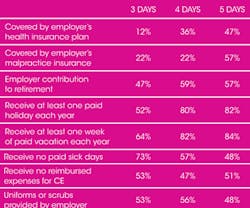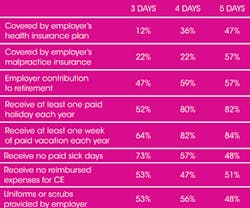2013 salaries and benefits
A partial summary of statistics that appeared in RDH eVillage
Editor's Note: RDH magazine collaborated with RDH eVillage to present salary and benefits information about the dental hygiene profession in articles appearing on DentistryIQ.com throughout 2013. A variety of statistics appeared in each article. A url is provided after each snippet below, and we encourage readers to read the entire article online to view statistics relevant to them. The first snippet below is the introduction to the last article appearing in the series.
Quote stats during negotiations?
One reader recently wrote that the salary surveys can hamper salary negotiations. She didn't specify whether it was this salary survey that caused things to go south, but we get the point.
Here's how these things typically go:
Dentist: "Well, I've enjoyed our conversation this morning. I think you would be a good fit for my practice. Built it from the ground up myself over these last 20 years. What would it take to get you on board and helping my patients achieve optimal oral health?"
Job candidate suggests a salary based on what he or she read in a salary survey. There is a pause and the dentist looks her in the eye. Suddenly, the candidate feels a knot in her stomach. She imagines any moment the doctor will be rolling on the floor laughing, coughing up breakfast, and slamming the door so hard she feels the breeze fan her posterior.
Naturally, we would never recommend using this article as the only research you do on whether to accept a job. (Note: If this feels like we are throwing you out, alone, into a pool of sharks, then, yeah, that's probably close to the truth.)
Here is where we want to be clear: Only you can decide on a career change, or whether a response to a request for a raise is reasonable.
Salary surveys are supposed to be informative, but only to a point. Not everyone responds to them, so who knows if the averages make prospective employers smile, sweat, or groan in dismay? We certainly don't.
Dentists never look at salary surveys to decide what kind of offer they're going to make if someone gullible walks in for a job. Wink, wink.
When more people respond to a survey, it stands to reason that the numbers are more accurate than when fewer people respond. With that in mind, we offer the results of the 2013 RDH eVillage salary survey in chronological order, not alphabetical order. The states with the most responses appear first, while ... we'll let you guess who ends up at the bottom.
Seriously, good luck with your next interview. Sorry we couldn't be there with you, cheering you on with some great insider tips. But you're a dental hygienist, of course, and, as long as you're not applying for the same job with 200 other dental hygienists in the neighborhood, we think you'll do fine.
To view this article, click here.
Job benefits, based on hours worked
The more you work, the more benefits you earn (see related table). Yes, we know; many hygienists would love to work more hours to qualify for benefits.
But what's the deal with part-timers being more likely to have an employer provide a uniform? Does the increased wealth of $200 to $400 a week mean the rich hygienists should just buy their own uniforms?
To view this article, click here.
Health benefits, national overview
The largest determinant of whether a dental hygienist receives health insurance is her job status of part-time vs. full-time employee. Forty-one percent of hygienists who work out of one office for four or more days a week derive health insurance benefits from their employer. In comparison, 7% of hygienists who work three or fewer days in one office utilize health insurance benefits through the employer.
A veteran hygienist added, "In almost 40 years in dentistry, I have only had benefits about half of the time, yet have always worked full time, five days a week."
To view this article, click here.
Benefits statistics from Texas
Who responded: 62 full-time hygienists out of 84 total
Paid holidays: 32% are off with pay for six holidays; 16% said they are paid for five holidays; and 11% enjoy 10 or more paid holidays each year.
Paid vacation: 27% have three or more weeks off each year; 27% have two weeks of paid vacation each year; and 24% enjoy one week. 37% said vacation leave is a standard policy that does not increase with years of service.
Paid sick leave: Up to five days (27%); up to 10 days (3%); up to 15 days (2%); more than 15 days (5%). 61% said they do not receive paid sick days. Of the 39% receiving paid sick days, 28% said they are paid a cash equivalent for unused days.
Continuing education: 24% are reimbursed for all CE costs. Tuition is reimbursed for 21%, but not other expenses. 55% of dental hygienists pay all of their own CE expenses. 31% are paid their salary for CE on regularly scheduled workdays.
Uniforms: Employers provide uniforms or scrubs for 50% of respondents.
To view this article, click here.
Insurance coverage in Ohio
Who responded: 87 total, including 60 full-time hygienists (69%)
Health insurance: 53% are covered through a family member's plan; 33% are covered by an employer's plan; and 14% are uninsured.
Dental insurance: 40% receive treatment at reduced cost at employer's practice; 26% are uninsured; 25% are covered by a family member's plan; and 9% are covered by plan provided by employer.
Disability insurance: 72% are uninsured; 14% are covered by self-initiated coverage; and 14% are covered by an employer's plan.
Malpractice insurance: 44% are uninsured; 36% are covered by self-initiated coverage; and 20% are covered by employer's plan.
Retirement plan: 68% have a retirement plan where employer makes a contribution to it.
Life insurance: 8% are covered through an employer's plan.
To view this article, click here.
Frequency of pay raises
The survey asked dental hygienists to indicate when they last received a raise within the following time frames:
- 40% said the last raise was more than five years ago
- 34% said the last raise was more than a year ago
- 15% said the last raise was within the last 12 months
- 9% said they have never received a raise
To view this article, click here.
Who gets a raise?
Who's favored in terms of getting a raise in a dental office? The hygienists said (475 answered this question; 587 hygienists overall participated in the survey):
- Front desk personnel (24%)
- Dental assistant (23%)
- Office manager (18%)
- Another hygienist (12%)
- All other staff positions (9%)
To view this article, click here.
Surplus of dental hygiene schools
Veteran hygienists were slightly more likely to believe that it is "more obvious" that an increase in the number of dental hygiene schools is "creating a larger surplus of dental hygienists seeking employment." Percentage of hygienists, based on experience level, who believe there are too many dental hygiene schools:
- Graduated in the 1970s: 86%
- Graduated in the 1980s: 80%
- Graduated in the 1990s: 78%
- Graduated after 2000: 79%
To view this article, click here.
Desire for more hours in the city
Among hygienists who practice in metropolitan areas, 24% wish they worked more frequently, compared to 18% in rural areas. Specifically, hygienists in the Chicago area indicated the greatest desire to work more shifts (37%).
A Chicago hygienist noted, "Very difficult to find jobs in my area. I am underemployed due to tough economic times. The doctor's schedule is slow, so he works on many hygiene patients to keep his schedule busy."
To view this article, click here.
Income statistics for Boston
- Most common hourly rates for 2013: $40, $45, $38, $39
- Most common hourly rates for 2012: $38, $40, $39, $45
- 16% projected their 2013 annual income from dental hygiene would fall in the $61,000 to $65,000 range, and 16% projected the $56,000 to $60,000 range.
To view this article, click here.
Income statistics from California
78% of the respondents practice in metropolitan areas, where the most common hourly rates were $50 (19%), more than $56 an hour (17%), and $45 (14%). The most common daily rates reported in metropolitan areas were $376 to $400 range (27%). The most common hourly rates for hygienists in small town/rural settings were $40, $41, $43, and $50.
To view this article, click here.

